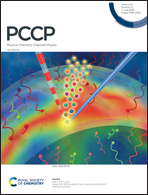Hybrid density functional theoretical study of NASICON-type NaxTi2(PO4)3 (x = 1–4)
Abstract
Sodium Super Ionic Conductor (NASICON) structured phosphate framework compounds represent a very attractive class of materials for their use as Na-ion battery electrodes. A series of NASICON-structured NaxTi2(PO4)3 compounds corresponding to varying degrees of sodiation (x = 1–4) have been investigated using high-level hybrid density functional theory calculations using the Linear Combination of Atomic Orbitals and Gaussian-type basis set formalism together with hybrid B1WC and HSE06 exchange–correlation functionals. Using primitive cells of NaxTi2(PO4)3 compounds with different stoichiometry, sodium sublattice structure and titanium oxidation states are constructed and analyzed using group theoretical symmetry considerations. The existence of mixed titanium oxidation states for x = 4 (Ti2+/Ti3+) and x = 2 (Ti3+/Ti4+) and a single oxidation state for x = 1 (Ti4+) and x = 3 (Ti3+) has been demonstrated. The results show a necessary set of symmetry reductions taking place due to the highest possible sodium/vacancy and titanium charge ordering with changing x. For each composition, an electroneutrality condition for the oxidation states of all atoms was applied which led to the discovery of several energy minima corresponding to different electronic configurations as identified by different Ti magnetic moments. An interesting relation between the bulk electronic properties of NaxTi2(PO4)3 compounds and the variation of sodium content was also found. In addition to sodium and titanium oxidation state charge ordering, the existence of large differences between the origin and the size of the band gap is shown. The band gap changes from the 4.05 eV 2p–3d gap in Na1Ti2(PO4)3 to the 0.59 eV 3d–3d gap in Na4Ti(PO4)3 with extra states due to mixed titanium valence. These results serve as an important electronic structure benchmark for further studies of such polyanion materials and help to explain some important properties of these systems relevant to battery applications.

- This article is part of the themed collection: 2020 PCCP HOT Articles


 Please wait while we load your content...
Please wait while we load your content...